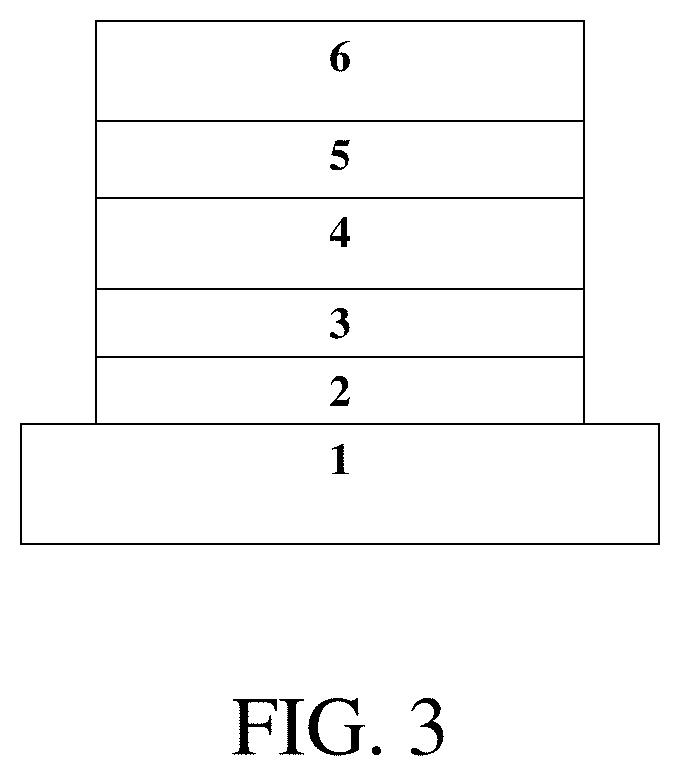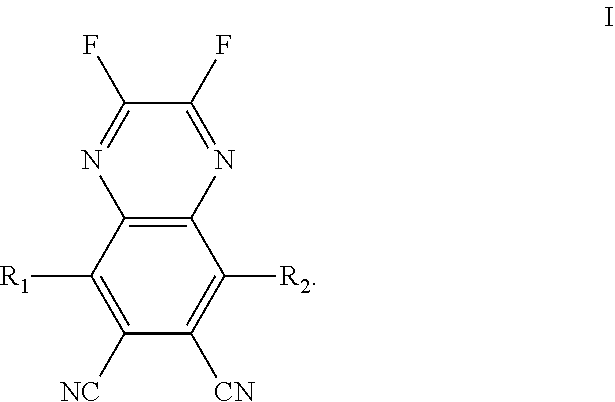Efficient blue-green to orange-red thermally activated delayed fluorescence material, manufacture method, and application thereof
a thermal activation and fluorescence material technology, applied in the field of organic electroluminescent diodes, can solve the problems of limiting the application of fluorescent electroluminescent devices, phosphorescent materials with heavy metal complexes that have not yet been advanced in terms of blue light materials, and the quantum efficiency (iqe) of fluorescent materials can only reach 25%, so as to achieve high efficiency, reduce singlet-triplet energy difference, and increase the effect of material luminous efficiency
- Summary
- Abstract
- Description
- Claims
- Application Information
AI Technical Summary
Benefits of technology
Problems solved by technology
Method used
Image
Examples
example 1
[0085]Synthesis scheme of target compound 1 is as follows:
[0086]Synthesis steps: the raw material 1 (2.09 g, 5 mmol), 9,10-dihydro-9,9-diphenyl acridine (2.00 g, 6 mmol), palladium acetate (45 mg, 0.2 mmol), and tri-tert-butylphosphine tetrafluoroborate (0.17 g, 0.6 mmol) are added into 100 mL two-neck bottle. Further, NaOt-Bu (0.58 g, 6 mmol) is added into the two-neck bottle in a glove box, and then 40 mL toluene deoxygenated and dehydrated beforehand is added under argon for a reaction at 120° C. for 24 hours. Afterward, the reaction mixture is cooled to room temperature and then poured into 200 mL ice water, following by extracting with dichloromethane for 3 times. The organic phases are combined and mixed with a silica gel under a spinning condition, following by separating and purifying by a column chromatography (dichloromethane:n-hexane=3:2 (v:v)). Finally, 1.6 g of sky blue powder (i.e., compound 1) is obtained with a yield of 64%. 1H NMR (300 MHz, CD2Cl2, δ): 7.55-7.46 (s,...
example 2
[0087]Synthesis scheme of target compound 2 is as follows:
[0088]Synthesis steps: the raw material 1 (2.09 g, 5 mmol), phenoxazine (1.10 g, 6 mmol), palladium acetate (45 mg, 0.2 mmol), and tri-tert-butylphosphine tetrafluoroborate (0.17 g, 0.6 mmol) are added into 100 mL two-neck bottle. Further, NaOt-Bu (0.58 g, 6 mmol) is added into the two-neck bottle in a glove box, and then 40 mL toluene deoxygenated and dehydrated beforehand is added under argon for a reaction at 120° C. for 24 hours. Afterward, the reaction mixture is cooled to room temperature and then poured into 200 mL ice water, following by extracting with dichloromethane for 3 times. The organic phases are combined and mixed with a silica gel under a spinning condition, following by separating and purifying by a column chromatography (dichloromethane:n-hexane=3:2 (v:v)). Finally, 1.5 g of green powder is obtained with a yield of 63%. 1H NMR (300 MHz, CD2Cl2, δ): 7.55-7.46 (s, 5H), 7.14-7.07 (m, 2H), 7.01-6.90 (m, 6H). M...
example 3
[0089]Synthesis scheme of target compound 3 is as follows:
[0090]Synthesis steps: the raw material 1 (2.09 g, 5 mmol), phenothiazine (1.19 g, 6 mmol), palladium acetate (45 mg, 0.2 mmol), and tri-tert-butylphosphine tetrafluoroborate (0.17 g, 0.6 mmol) are added into 100 mL two-neck bottle. Further, NaOt-Bu (0.58 g, 6 mmol) is added into the two-neck bottle in a glove box, and then 40 mL toluene deoxygenated and dehydrated beforehand is added under argon for a reaction at 120° C. for 24 hours. Afterward, the reaction mixture is cooled to room temperature and then poured into 200 mL ice water, following by extracting with dichloromethane for 3 times. The organic phases are combined and mixed with a silica gel under a spinning condition, following by separating and purifying by a column chromatography (dichloromethane:n-hexane=3:2 (v:v)). Finally, 1.1 g of orange powder is obtained with a yield of 45%. 1H NMR (300 MHz, CD2Cl2, δ): 7.55-7.46 (s, 5H), 7.26-7.14 (m, 6H), 7.01-6.96 (m, 2H)...
PUM
 Login to View More
Login to View More Abstract
Description
Claims
Application Information
 Login to View More
Login to View More - R&D
- Intellectual Property
- Life Sciences
- Materials
- Tech Scout
- Unparalleled Data Quality
- Higher Quality Content
- 60% Fewer Hallucinations
Browse by: Latest US Patents, China's latest patents, Technical Efficacy Thesaurus, Application Domain, Technology Topic, Popular Technical Reports.
© 2025 PatSnap. All rights reserved.Legal|Privacy policy|Modern Slavery Act Transparency Statement|Sitemap|About US| Contact US: help@patsnap.com



